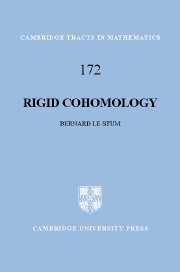9 - Conclusion
Published online by Cambridge University Press: 09 October 2009
Summary
A brief history
As already mentioned, p-adic cohomology first showed up in an informal way in the work of Bernard Dwork ([39]) in the late 1950s. In the 1960s and 1970s, crystalline cohomology was developed by Pierre Berthelot (and others) and at the same time, Monsky—Washnitzer cohomology was developed by Paul Monsky (and others). The first one is suitable for proper smooth algebraic varieties and the second one for smooth affine varieties. Both theories were united by Pierre Berthelot in the early 1980s (see [11]), giving birth to rigid cohomology. The development of this theory can be split into three periods.
The first one is dedicated to foundations, and we gave it a rather complete treatment in this book. Actually, the rigid cohomology spaces of a given algebraic variety are not that hard to define. As we saw, we just need to compactify, embed into some smooth formal scheme and take the limit de Rham cohomology on strict neighborhoods. And in the quasi-projective case, this is even simpler. The main difficulty is to show that the results do not depend on the choices. The basic ingredient is the Fibration Theorem. Berthelot laid these foundations in the early 1980s.
The second period starts with Johan de Jong's alterations theorem ([35]).
- Type
- Chapter
- Information
- Rigid Cohomology , pp. 299 - 309Publisher: Cambridge University PressPrint publication year: 2007

